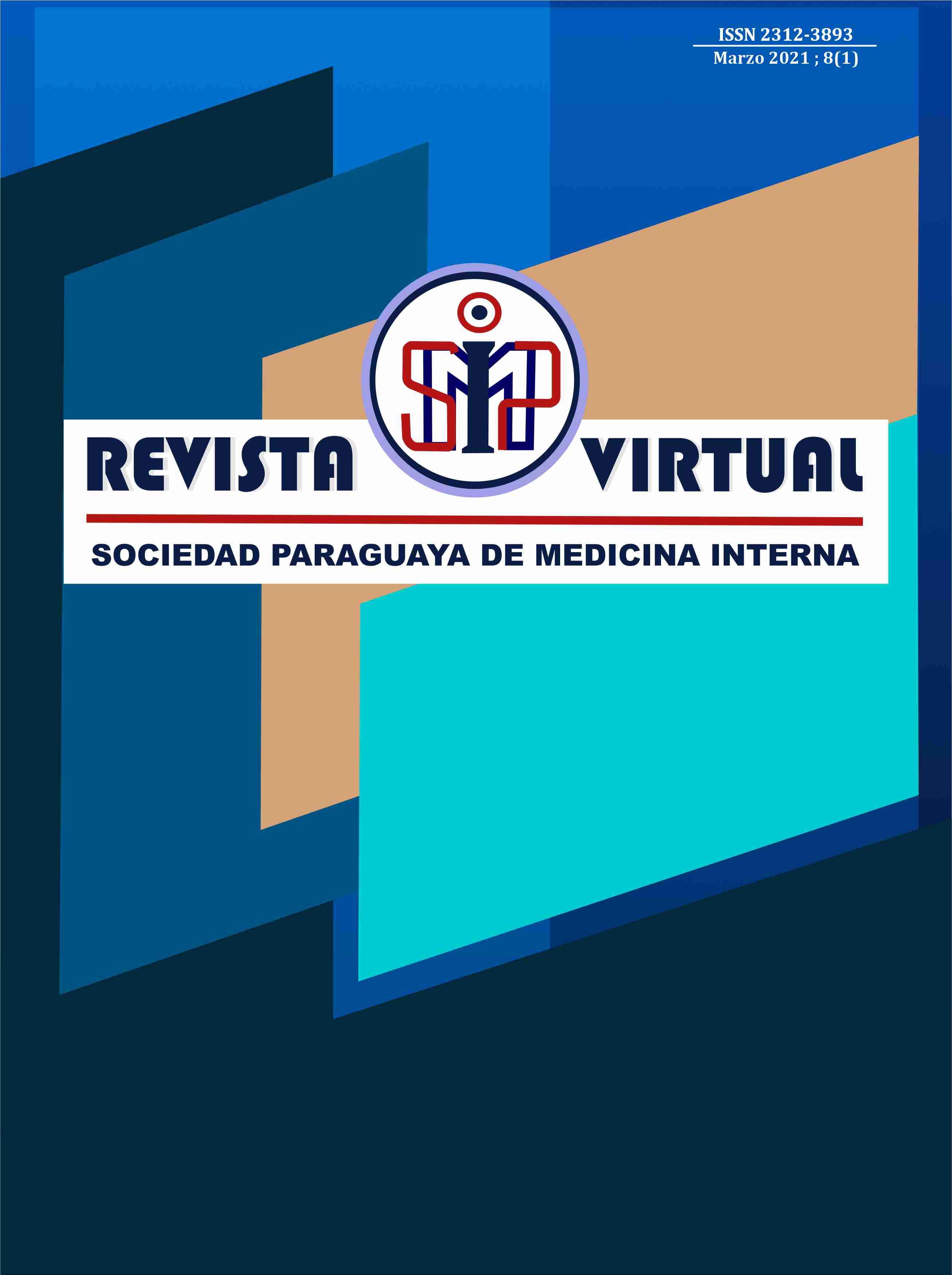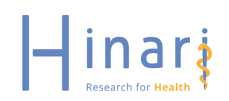Características demográficas, clínicas y de electromiografía en pacientes con Síndrome de Guillain-Barré
Abstract
Introducción: el Síndrome de Guillain-Barré es una polirradiculoneuropatía aguda causante de parálisis fláccida, generalmente ascendente. Los pacientes frecuentemente tienen antecedentes de infecciones previas, usualmente de tipo respiratorio o gastrointestinal.
Objetivo: describir las características demográficas, clínicas y electromiografías de los pacientes con Síndrome de Guillain-Barré en el Hospital Central del Instituto de Previsión Social (Asunción, Paraguay) en el periodo agosto 2015 a setiembre 2017, además de analizar variables potencialmente relacionadas al desenlace clínico.
Metodología: diseño observacional con corte transversal. Población: 30 pacientes con diagnóstico confirmado de Síndrome de Guillain-Barré.
Resultados: edad promedio de 46,6 ± 15,8 años, 53,3% sexo masculino, 26,7% con antecedentes de enfermedad respiratoria, 20,0% con antecedentes de diarrea, 10,0% con antecedentes de dengue, 53,3% con disociación albúmino-citológica en líquido cefalorraquídeo. En la electromiografía se halló patrón desmielinizante en el 46,7%, patrón axonal motor en el 26,7% y axonal motor sensitivo en el 23,3%. Semiológicamente hubo 100% con trastornos motores, 33,3% con trastornos sensitivos, 3,3% con trastornos autonómicos. Respecto al tratamiento, 60,0% fueron tratados antes de los seis días de enfermedad, 100% con inmunoglobulinas. Hubo 66,7% con mejoría clínica y 3,3% fallecidos. No se identificaron variables asociadas significativamente al desenlace clínico.
Conclusiones: predominó el sexo masculino, la edad media fue 46,6 años. Los antecedentes más comunes fueron las infecciones respiratorias y diarrea. La disociación albúmino-citológica se observó en 53,3%. Por electromiografía, el patrón más frecuente fue de tipo desmielinizante, seguido por el de tipo axonal motor.
References
2. Donofrio PD. Guillain-Barré syndrome. Continuum (Minneap Minn). 2017; 23(5):1295-1309. doi: 10.1212/CON.0000000000000513.
3. van den Berg B, Walgaard Ch, Drenthen J, Fokke Ch, Jacobs BC, van Doorn PA. Guillain–Barré syndrome: pathogenesis, diagnosis, treatment and prognosis. Nat Rev Neurol. 2014; 10(8):469-82. Doi: 10.1038/nrneurol.2014.121.
4. Créange A. Guillain-Barré syndrome: 100 years on. Revue Neurologique. 2016;172(12):770-774.
5. Kılıç B, Güngör S, Özgör B. Clinical, electrophysiological findings and evaluation of prognosis of patients with Guillain-Barré syndrome. Turk J Pediatr. 2019; 61(2):200-208. doi: 10.24953/turkjped.2019.02.008.
6. Leonhard S, Mandarakas M, Gondim FAA, Bateman K, Ferreira MLB, Cornblath DR, et al. Diagnosis and management of Guillain–Barré syndrome in ten steps. Nat Rev Neurol. 2019; 15(11):671-83. doi:10.1038/s41582-019-0250-9.
7. Erdogmus Ince N, Fevzi Öztekin M, Öztekin N. Acute motor conduction block neuropathy: Another distinct variant of Guillain-Barre syndrome. Noro Psikiyatr Arş. 2014; 51(1):82-85. doi: 10.4274/npa.y6851.
8. Hafsteinsdóttir B, Ólafsson E, Jakobsson F. Incidence and outcome of Guillain-Barré syndrome in Iceland: A population-based study. Acta Neurol Scand. 2018; 138(5):454-8. doi: 10.1111/ane.13000.
9. Ortona E, Pierdominici M, Maselli A, Veroni C, Aloisi F, Schoenfeld Y. Sex-based differences in autoimmune diseases. Ann Ist Super Sanita. 2016; 52(2)205-12. doi: 10.4415/ANN_16_02_12.
10. Cabanellas López VH, Martínez VH, Yubero RA, Céspedes L. Insuficiencia respiratoria aguda en el Síndrome de Guillain Barré. Rev. virtual Soc. Parag. Med. Int. 2014; 1(2): 42-53. doi:10.18004/rvspmi/2312-3893/ 2014.01 (02) 42-053
11. Liu S, Xiao Z, Lou M, Ji F, Shao B, Dai H, et al. Guillain-Barré syndrome in southern China: retrospective analysis of hospitalised patients from 14 provinces in the area south of the Huaihe River. J Neurol Neurosurg Psychiatry. 2018; 89(6):618-26. doi: 10.1136/jnnp-2017-316930.
12. Rojas G, Real R, Aveiro A, Correa D, Ruiz L, Fridman V, et al. Síndrome de Guillain Barré asociado al dengue. Reporte de dos casos. Rev. Nac. (Itauguá). 2013; 5(2): 41-3.
13. Tan ChY, Omaira Razali SN, Goh KJ, Sam ICh, Shahrizaila N. Association of dengue infection and Guillain-Barré syndrome in Malaysia. J Neurol Neurosurg Psychiatry. 2019; 90(11):1298-1300. doi: 10.1136/jnnp-2019-320756.
14. Rudant J, Dupont A, Mikaeloff Y, Bolgert F, Coste J, Weill A. Surgery and risk of Guillain-Barré syndrome: A French nationwide epidemiologic study. Neurology. 2018; 91(13):e1220-e1227. doi: 10.1212/WNL.0000000000006246
15. Langmuir AD, Bregman DJ, Kurland LT, Nathanson N, Victor M. An epidemiologic and clinical evaluation of Guillain-Barré syndrome reported in association with the administration of swine influenza vaccines. Am J Epidemiol. 1984;119(6):841-79. doi: 10.1093/oxfordjournals.aje.a113809.
16. Sánchez Vides WE. Síndrome Guillain-Barré posterior a vacunación antirrábica. Rev Mex Neuroci. 2006; 7(3), 246-8.
17. McMahon AW, Eidex RB, Marfin AA, Russell M, Sejvar JJ, Markoff L, et al. Neurologic disease associated with 17D-204 yellow fever vaccination: A report of 15 cases. Vaccine. 2007; 25(10):1727-34. doi: 10.1016/j.vaccine.2006.11.027.
18. Principi N, Esposito S. Vaccine-preventable diseases, vaccines and Guillain-Barre’ syndrome. Vaccine. 2019; 37(37):5544-50. doi: 10.1016/j.vaccine.2018.05.119.
19. Greene ShK, Rett MD, Vellozzi C, Li L, Kulldorff M, Marcy SM, et al. Guillain-Barré syndrome, influenza vaccination, and antecedent respiratory and gastrointestinal infections: A case-centered analysis in the vaccine safety datalink, 2009–2011. PLoS One. 2013; 8(6):e67185. doi: 10.1371/journal.pone.0067185.
20. Chen Y, Zhang J, Chu X, Xu Y, Ma F. Vaccines and the risk of Guillain-Barré syndrome. Eur J Epidemiol. 2020; 35(4):363-70. doi: 10.1007/s10654-019-00596-1.
21. Centers for Disease Control and Prevention. Fact sheet: Guillain-Barré Syndrome (GBS). [Internet]. Atlanta: Centers for Disease Control and Prevention; 2009. [cited 2020 Jul 11]. Available from: https://www.cdc.gov/h1n1flu/vaccination/factsheet_gbs.htm
22. Centers for Disease Control and Prevention. Vaccine Adverse Event Reporting System (VAERS). [Internet]. Centers for Disease Control and Prevention;
2017 [cited 2020 Jul 11]. Available from: https://www.cdc.gov/vaccinesafety/ensuringsafety/monitoring/vaers/index.html
23. Vidrio-Becerra ME, Valle-Leal J, Loaiza-Sarabia ME, Alvarez-Bastidas L, Lachica-Valle JI, López-Morales CM. Valor de la concentración de proteínas en el líquido cefalorraquídeo en pacientes pediátricos con síndrome de Guillain-Barré. Medicina Clínica. 2018; 150(9):331-5.
24. de la O-Peña D, Robles-Figueroa M, Chávez-Peña Q, Bedolla-Barajas M. Características del síndrome de Guillain-Barré en adultos: resultados de un hospital universitario. Rev Med Inst Mex Seguro Soc. 2015;53(6):678-685
25. Fan Ch, Jin H, Hao H, Gao F, Sun Y, Lu Y, et al. Anti-ganglioside antibodies in Guillain-Barré syndrome and chronic inflammatory demyelinating polyneuropathy in Chinese patients. Muscle Nerve. 2017;55(4):470-5. doi: 10.1002/mus.25266.
26. Akbayram S, Dogan M, Akgün C, Peker E, Sayin R, Aktar F, Bektas M-S, Caksen H. Clinical features and prognosis with Guillain-Barré syndrome. Ann Indian Acad Neurol. 2011;14(2):98-102. doi: 10.4103/0972-2327.82793.
27. Othman BA, Raabe J, Kini A, Lee AG. Update: the Miller Fisher variants of Guillain-Barré syndrome. Curr Opin in Ophthalmol. 2019; 30(6):462-6.
28. Capasso M, Caporale CM, Pomilio F, Gandolfi P, Lugaresi A, Uncini A. Acute motor conduction block neuropathy Another Guillain-Barre syndrome variant. Neurology. 2003; 61(5):617-22.
29. Doets AY, Verboon Ch, van den Berg B, Harbo T, Cornblath D, Willison H, et al. Regional variation of Guillain-Barré syndrome. Brain. 2018; 141(10):2866-77. doi: 10.1093/brain/awy232.

















